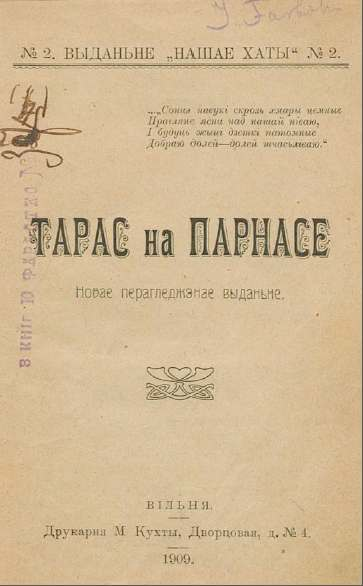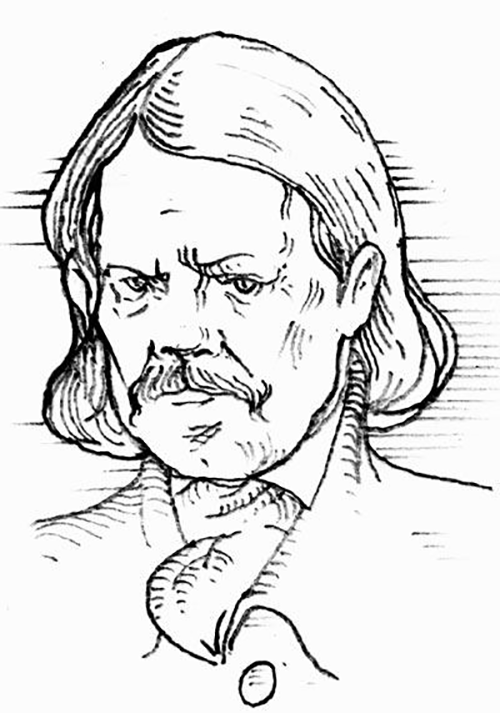Title of the work
Country of the First Edition
Country/countries of popularity
Original Language
First Edition Date
First Edition Details
Taras on Parnassus was first published in 1889 in the Minskii listok newspaper (№37/ May 16) as an anonymous poem.
The first book edition (also anonymous) was issued by the Vitsebsk province printing house in 1896. The poem is divided into 15 parts with 15–25 lines in each part.
Available Onllne
Original version (accessed: March 15, 2018).
English translation by Walter May (accessed: March 15, 2018).
Russian translation by Mikhail Lozinskiĭ (accessed: March 15, 2018).
Genre
Poetry
Target Audience
Young adults
Cover

Cover of the edition from 1909, Vilnia: Drukarnia M[artsina] Kuhty [Вільня: Друкарня М[арціна] Кухты]. Retrieved from kamunikat.org. Copyright © 2000-2022 by Kamunikat.org (all links accessed: April 6, 2022).
Author of the Entry:
Maria Pushkina, National Academic Janka Kupała Theatre, maryiapushkina@gmail.com
Peer-reviewer of the Entry:
Elżbieta Olechowska, University of Warsaw, elzbieta.olechowska@gmail.com
Elizabeth Hale, University of New England, ehale@une.edu.au

Courtesy of Siarhei Khareŭski.
Kanstantsin Veranitsyn
, 1834 - 1904
(Author)
Kanstantsin Veranitsyn (Vasil’eŭ; Канстанцін Вераніцын, Васільеў) was born in Astraŭliany village (Vitsebsk region, Belarus) into a family of serf peasants, who were owned by the landlord Vasil’ Bondaraŭ. At the age of eleven Kanstantsin received freedom and aquired his surname Veranitsyn. It is quite possible, that Kanstantsin Veranitsyn was an illegitimate son of his landlord. He went to the parish school of Haradok, Vitsebsk provincial gymnasium (1845–1852) and studied at St. Petersburg Medical and Surgical Academy (1852–1854). In 1854 Veranitsyn was expelled from the Academy, but in 1859 he graduated from Horki Agricultural Institute with his final work “On the Belarusian economy”. In 1863-1874 he lived and worked in St. Petersburg, in 1874-1879 he worked as a teacher at Maladzechna Teachers' Seminary. Since 1880 he worked for the Ministry of Railways in St. Petersburg in the rank of state councilor. The exact date of his death is unknown. Except Taras on Parnassus, there is only one poem (The two devils) that is thought to have been written by Kanstantsin Veranitsyn.
Sources:
Kisialioŭ, Henadz’ [Кісялёў, Генадзь], Жылі-былі класікі: хто напісаў паэмы Энеіда навыварат і Тарас на Парнасе [Once upon a time, classics lived here: who wrote “Aeneid Inside Out” and “Taras on Parnassus”], Minsk: Беларуская навука [Belaruskaia navuka], 2005.
Bio prepared by Maria Pushkina, National Academic Janka Kupała Theatre, maryiapushkina@gmail.com
Translation
English: Taras on Parnassus: a folk poem, trans. Walter May, Minsk, Iunatstva, 1998, available online:http://knihi.com/none/Taras_on_Parnassus_Folk_Poem-en.html (accessed March 15, 2018); Taras na Parnasie, trans. Arnold McMillin, Vera Rich, London, The Journal of Byelorussian Studies IV. 1, Year XIII.
Russian: Тарас на Парнасе, trans. Mikhail Lozinskii, Minsk, 1953, available online: http://gcb.belcult.by/files/pdf/Taras-na-Parnase-rus.pdf (Accessed March 15, 2018);
Ukrainian: Тарас на Парнасі, trans. Valeryi Stralko, Minsk, 2003.
German: Tarass auf dem Parnass, trans. Uladsimir Papkowitsch, Annus Albaruthenicus, Villa Sokrates, Krynki, 2006.
Multilingual edition: Wincenty Dunin Marcinkiewicz, Pinskaya Shlakhta: authetic text, translation in Belarusian, English, German, Polish, Russian; Kastus’Veranitsyn, Taras na Parnase: Belarusian, English, Bulgarian, Spanish, German, Polish, Russian, Ukrainian [fragments], Minsk:Viktar Khursik, 2009.
Summary
After a long usual journey through the forest, Taras, the forester, the main protagonist and narrator of the poem, falls into a pit and finds himself on at the base of Mount Parnassus. A little Cupid (“curly-headed, like a sheep” with a quiver of arrows and a hefty bow) guides him to the top. Taras passes a large group of writers climbing the mountain (he notices that not everyone is allowed to enter) and finally gets to the top where he realizes that he is surrounded by Greek gods who live and behave just like Belarusian peasants. They work hard and do their housekeeping. We see Zeus, Saturn, Jupiter, Neptune, Mars, Bacchus, Cupid, Hebe, Vesta, Venus, Hercules, Nymphs, Naiads, Zephyrus. All of them have their duties according to their function in Greek mythology and to traditional folk household chores and everyday activities: Saturn makes new bast shoes, Neptune mends fishnets, Zeus lies on the warm stove-top watching Mars fight with Hercules, goddesses do the laundry and Venus spends her time near the mirror. Parnassus gods have their feasts with folk dances, they eat national Belarusian dishes and drink harelka (vodka). Taras joins the party (he is keen on music), gets a complement for his dancing skills from Jupiter, gets some food from Hebe and decides to go back home. Zephyrus helps him to get back to his forest.
The poem has a narrative frame (a foreword and an afterword), in which the author acknowledges that he has written down this story straight from Taras, who is “a quiet fellow, / no liquor ever touched his lips”. From this point Taras on Parnassus is a story within a story used to parody the image of an ordinary peasant, his values and way of thinking.
Analysis
Taras on Parnassus is one of the most important works of 19th-century Belarusian literature. This poem became the fundamental text of the national literary tradition for many generations of scholars and readers. It is also one of the most mysterious texts because of its long way to proper authorship attribution, date and place of origin, publication, further copies, changes and comments. In the poem, the ancient gods are transferred to the 19th century, so we can see how different epochs and different cultures meet and unite. Kanstantsin Veranitsyn found a way to combine the truth of life and classical mythology. Mythological figures in Taras on Parnassus are presented in grotesque and burlesque terms. By caricaturing the manner and spirit of classical characters, the author exposes the false interest in folk culture, which official literature used to demonstrate at the end of the 19th century.
The reception of Parnassus in the poem corresponds with the general concept of God's mountain and shows traits of two sacred mountains, Olympus and Parnassus. Taras’ ascension to the top of “the home of the Muses” symbolizes an ascent (or the possibility of an ascent) of Belarusian literature to the height of world classical culture. The presence of a simple forester on top of Parnassus proves the right of ordinary people to have their own literature, this is how the change of literature’s main recipient is revealed.
Many copies of Taras on Parnassus were published with a special mythological dictionary which included short definitions of classical characters mentioned in the poem. By means of this dictionary and by the use of iambic tetrameter (classical meter in Slavic poetry, associated with Pushkin’s light and simple verse forms, which is especially important because Veranitsyn allows Pushkin, Lermontov and Zhukovskiĭ to enter Parnassus in his poem) the poem performs its educational function. It also describes basic Olympian characters and gives an opportunity to talk about classical Russian literature, comparing it with Belarusian literature. The poem also introduces the concept of irony, grotesque and satire as a genre.
Further Reading
Kisialioŭ, Henadz’ [Кісялёў, Генадзь], Жылі-былі класікі: хто напісаў паэмы "Энеіда навыварат" і "Тарас на Парнасе" [Once upon a time, classicslived here: whowrote “Aeneid Inside Out” and “Taras on Parnassus” (Zhyli-byli klasiki: khto napisaŭ paėmy "Ėneida navyvarat" i "Taras na Parnase")], Minsk: Беларуская навука [Belaruskaia navuka], 2005.
Kisialioŭ, Henadz’ [Кісялёў, Генадзь], Пошукі імя [Looking for aname (Poshuki imia)], Minsk: Мастацкая літаратура [Mastatskaia litaratura], 1978.
Shaŭtsoŭ, Piatro [Шаўцоў, Пятро], Спрадвечнае: даследаванне аб часе і месцы напісання “ананімных” паэм “Энеіда навыварат” і “Тарас на Парнасе” [The Eternal: a study of timeand place of writingof the “anonymous” poems “Aeneid Inside Out” and “Taras on Parnassus” (Spradvechnae: dasledavanne ab chase i mescy napisannia "ananimnyh" paėm "Ėneida navyvarat" i "Taras na Parnase")], Minsk: Мастацкая літаратура [Mastatskaialitaratura], 1973.
Zaprudski, Ihar [Запрудскі, Ігар], “Ялегі Пранціш Вуль і пытанне атрыбуцыі паэмы “Тарас на Парнасе” [Ialehi Prantsish Vul’ and thequestion of attribution of “Taras on Parnassus” (Ialehi Prantsich Vul' i pytanne atrybucji paėmy "Taras na Parnase")], Працы кафедры гісторыі беларускай літаратуры Белдзяржуніверсітэта [Pracy kafedry historyi belaruskaĭ litaratury Beldziarzhuniversitėta] 5: Minsk: Беларускі дзяржаўны ўніверсітэт [Belaruski dziarzhauny universitėt], 2004, 49–62.
Addenda
Kanstantsin Veranitsyn (1834–1904). The poem was considered anonymous until in 1971 Belarusian researcher Henadz’ Kisialioŭ found out the name of the author, and currently Taras on Parnassus is attributed to Kanstantsin Veranitsyn.
Target group: Originally the poem was dedicated to a wide range of poorly educated readers – peasants (this marks the change of the literature’s main recipient an the end of the 19th century), but also to readers who knew the phenomena of Saint Petersburg literary life described by the author. Currently the poem is included in the obligatory school curriculum for the 9th grade (14-15 years old Belarusian school students).
The book’s title written with the use of the Belarusian Latin script, łacinka (latsinka): Taras na Parnasie.


